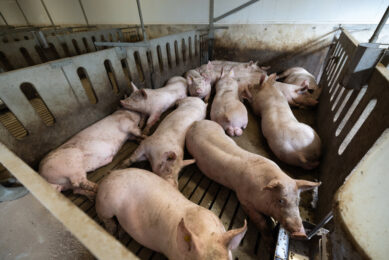FDA accepts Diamond V’s better DMI in diary cows, claim

The US’s Food and Drug Administration (FDA) has reviewed Diamond V’s transition cow studies, and accepted the claim that “Diamond V Original Product helps support dry matter intake (DMI) of dairy cows when fed as part of a total mixed ration during the first 70 days of lactation”.
According to the company, they have been working on figuring out the mechanism behind Diamond V’s intake enhancement in early lactation dairy cows. They have seen from farm observations that cows tend to be attracted to the aroma and flavour of Diamond V ‘s Original Product. Previous research has shown that cows fed Diamond V can have higher rumen bacterial numbers, increased levels of ruminal propionate, enhanced fiber digestion, and a more stable rumen environment during ration changes.
A human grade Diamond V product called EpiCor, which is produced using a manufacturing process similar to that used with the animal products, can balance or temper some components of the immune system. It is not know which specific or combinations of these possible mechanisms are primarily responsible for the intake response, but in reality, it could vary with the circumstances.
The easiest possible mechanism – cows simply like the unique aroma and flavor of Diamond V ‘s Original Product. The aromatic and flavour compounds could enhance intake, resulting in the additional milk and reduced body weight loss observed in our transition cow trials.
Greater amounts of propionate can result in higher levels of blood glucose, and a resultant increase in insulin secretion. One of the functions of insulin is to reduce adipose mobilization, which could lead to lower liver NEFA levels (nonesterified fatty acids), reduced oxidation of liver acetyl Co-A, and higher intakes from either an improvement in liver function or a reduction in satiety signals emanating from the liver (Allen et al., 2009).
Improved fiber digestibility could result in an increase in DMI whenever rumen fill was limiting intake. Fill limitations of DMI would most likely occur at peak intake, but could occur during the pre- and post-calving periods depending on dietary characteristics.
Additionally, on the vast majority of dairies there is a big dietary shift as cows calve and go on the fresh or high group diets. Diamond V’s Original Product may also be increasing intake if they assist rumen microbial populations in making that transition.
Lastly, there has been increased interest and research in looking at ways that inflammatory mediators (cytokines like TNF-α and IL-6) could have deleterious effects on DMI and performance during the transition period. For example, liver triglyceride levels doubled when TNF-α was injected into late lactation dairy cows (Bradford et al.,2009). Increasing levels of liver triglycerides could impair normal liver functions and increase the risk of metabolic disorders like ketosis. In another study (Evans et al., 2012), mice were injected with collagen to induce an arthritis similar to rheumatoid arthritis, an autoimmune disorder. Interestingly, mice that had been fed the human Diamond V product called EpiCor had significantly lower levels of IFN-α, an inflammatory mediator thought to influence activated macrophages and the production of cytokines like TNF-αand IL-6.











